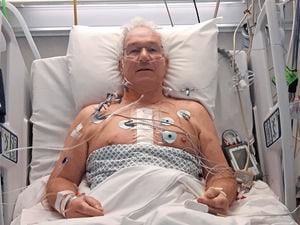Obituary: Sir John Coward: ‘One of the last pirate submarine captains’
THE son of a Sheerness ship-broker, John Francis Coward was born in Minster on the Isle of Sheppey on 11 October 1937.
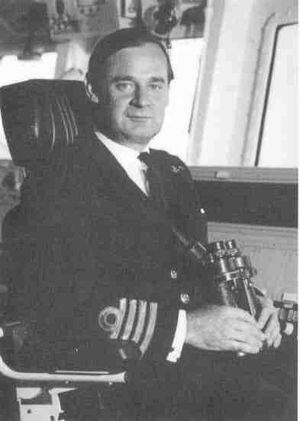
He was sent to Downside Catholic Boarding School near Bath, Somerset, and in 1954 he was accepted by Dartmouth College in Devon to train as a Royal Navy officer. He won the Queen’s Telescope Medal at his passing out parade.
After two years on the frigate HMS Tenby, he served in diesel-powered submarines from 1959. He was the first to command HMS Oracle, as a Lieutenant, in 1967 (Vice Admiral Sir Ian Corder, currently Guernsey’s Lt-Governor, was the last officer to command Oracle).
From 1970-77 he switched to nuclear submarines, commanding HMS Valiant while working in Australia, Canada and off the north coast of Russia.
After a spell as naval assistant to the First Sea Lord (1978-80) he was the first officer to command the brand new Type 22 frigate HMS Brilliant, based in Devonport, which would play an important role in the Falklands War (Operation Corporate). The ship was in Gibraltar in March 1982, berthed alongside Admiral Sandy Woodward’s ship, when the Admiral called for Captain John Coward and told him that a Royal Navy submarine had been dispatched to the South Atlantic as a precaution.
‘The cover story is that it’s exercising with somebody and that somebody had better be you,’ said Woodward. ‘So get out of here this afternoon and meet it.’
Before making a hasty departure, Coward managed to run in the Squadron Sports Day veterans’ race and finished first.
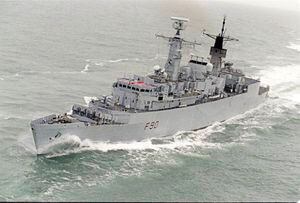
Brilliant was part of a convoy along with the destroyers Glasgow, Sheffield and Coventry, the frigate Arrow and the tanker Appleleaf. It provided an airborne anti-submarine capability in the form of two Lynx helicopters and hull-mounted sonar. She was the first Royal Navy warship to fire the Sea Wolf missile in action.
On 12 May 1982 she shot down three Argentinian A-4 Skyhawks. On 21 May the ship came under Argentine air attack outside San Carlos Water and was damaged by cannon fire. Two days later she joined HMS Yarmouth in the chase of the Argentinian supply ship ARA Monsunen, which was eventually run onto the shore.
Brilliant rescued 24 survivors from Atlantic Conveyor, a requisitioned British merchantman. Another time it rescued injured members of D Squadron from the sea following a helicopter crash. In his book ‘Across an Angry Sea: the SAS in the Falklands War’, Officer Commanding D Squadron, 22 SAS, General Sir Cedric Delves, described Coward’s ship as: ‘Not only Brilliant by name, but also brilliant by nature. Throughout the war it was always there when needed.’
Coward was awarded the Distinguished Service Order (DSO) for ‘exceptional professional ability, stamina, leadership, initiative and personal bravery’.
After his tenure on Brilliant ended, Coward became the Director of Naval Operational Requirements (1984). Promoted to rear-admiral in 1987, he went on to be Flag Officer Sea Training (1987-88), the perfect post to pass on his wealth of personal experience.
During his next appointment, as Flag Officer Flotilla One (1988-89), he arrived in his flagship, the destroyer Bristol, in Leningrad on the morning of 22 May 1989 when the British government expelled more than 400 Soviet diplomats and journalists. The visit, potentially disastrous, was successful due to the strong rapport which Coward formed with his Soviet Navy hosts.
He was knighted KCB in 1990 and in 1992 he was appointed Commandant of the Royal College of Defence Studies in Belgravia, London. He retired from the military in 1994 and became the Lt-Governor of Guernsey from that year until 2000.
Deputy Richard Graham was Sir John’s aide-de-camp.
‘He was my first governor and he asked me in 1998 for his last two years. I was 57 at the time but that didn’t phase him. It was a wonderful introduction and I enjoyed serving him so much. He came in unusual circumstances as Sir Michael Wilkins, the previous Lt-Governor, had died in office and the system was cranked into top gear and he was appointed.’
Richard said that Sir John had a good instinct into what made Guernsey tick.
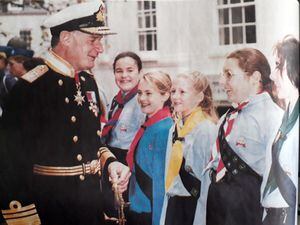
‘It needs a sensitive Lt-Governor to represent the Crown in the island and to represent Guernsey to the Crown.
‘20-odd years ago the inter-governmental relationship between the island and the UK wasn’t very good. In the past a Lt-Governor needed to smooth the waters over and this was needed in 1998. Jack Straw, the then-Home Secretary, was antipathetic towards crown dependencies. The Home Office ordered the Edwards Report, which was a review into the laws, systems and financial practices of the Channel Islands [and the Isle of Man]. It was a clumsy approach. But we got a tip-off from a civil servant friend of Sir John’s and the authorities over here were forewarned. In terms of regulating the Financial Services Commission, we ticked all the boxes.’
There was also some governmental consternation about the appointment of Jersey and Guernsey Bailiffs.
‘Tony Blair didn’t like the way that bailiffs were appointed. He wanted the position to be advertised out-of-island so all could apply. The view in Guernsey was “We’ll sort ourselves out, we’ll decide”. This required the Lt-Governor to say “Hands off”.’
Averting a possible constitutional crisis, the Home Office considered Sir John’s advice and backed down.
Richard also remembers Sir John as one of the best public speakers he had ever heard.
‘He had a photographic memory. Whenever he spoke in public he’d never take a written speech with him.
‘Norma Gardener, HE’s secretary, and I would often trigger something and Sir John would recite a piece of verse, doggerel or an extract from a book word perfect.
‘He also had a very sharp sense of humour. We were at Forest Primary School for an anniversary and they had got the youngest pupil and the oldest ex-pupil together. Sir John asked the oldest pupil how old he was. When he replied “90”, Sir John said: “Don’t you think it’s time you got a job?”’
Government House was also subject to Sir John’s energy and ‘can do’ attitude.
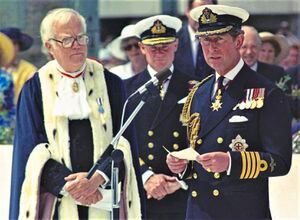
‘The place was overdue a makeover by about 20 years,’ said Richard. ‘It was an embarrassment, frankly. It needed a major makeover, not just maintenance. The west wing was to be redesigned and the States architect and I met HE one day and he gave the architect a piece of paper.
‘”I’ve been working on it overnight”, he said “Make it into a two-storey building with rooms above the ballroom.”’
It was built exactly to the plans sketched on the piece of paper and Sir John’s Office of the Lieutenant-Governor has since housed four incumbents, along with staff and countless visitors.
What Richard remembers most fondly is that Sir John was a man of the people.
‘He could mix with the posh and the not-so-posh, ambassadors and ministers, but equally, he’d go to the Halfway for a haircut or open a bottle of rum with the lifeboat crew.’
Deputy Mary Lowe and her husband Chris became good friends with Sir John and his wife Diana.
‘We met in 1994. I’d just got elected as a States member and John had just been appointed Lt-Governor. We were both new – or “new kids on the block” as John called us.’
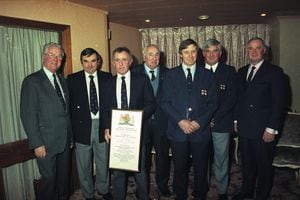
Mary, who was chairman of Guernsey Women’s Refuge, and Diana, who was patron of the charity, together with Island FM’s Kevin Stewart, persuaded Sir John to hold a fundraiser at Government House.
‘It was a fantastic day,’ said Mary. ‘We had live pop music at the front of the house and at the back we had Guernsey Concert Brass and afternoon teas. In the turnaround there were barbecues for hot dogs and burgers. The tennis courts were open and the Army came over. So many people had never been in the grounds before. There were a few raised eyebrows, but John really wanted to do it.’
The Lowes used to visit the Cowards in their home in Torpoint, Cornwall.
‘It was mandatory that you went on board John’s yacht. He loved sailing. We’d often sail off, find a port, anchor and take the dinghy for lunch ashore.
‘There was always tea and cakes around four or five, and then later, around 9pm, supper. But before supper, there’d be drinks and John would play the piano. Without sheet music. He was self taught. He’d take requests but he loved Gershwin. He said the piano exercised his fingers and was a good way to stave off arthritis.’
As well as a keen interest in sailing, gardening and golf, Sir John was actively involved in the RNLI in Guernsey. The current Guernsey Lifeboat Spirit of Guernsey came into service early in his tenure and he was a great supporter of both the crew and the charity. Sir John was appointed vice-president of the RNLI – at national level – as a mark of special recognition of his contribution to the lifeboat service.
Following Sir John’s death, Government House issued a statement in which Lt-Governor Sir Ian Corder said: ‘For me, as a fellow submariner, it’s no exaggeration to say that Sir John was something of a legend in the submarine service. He personally questioned me as part of my selection to command a submarine, in what is affectionately known as the “perisher” course, and I went on to command one of his former boats.’
Another senior Royal Navy Officer once described Sir John as ‘one of the last pirate submarine captains’.
. Vice Admiral Sir John Coward KCB, DSO, born 11 October 1937, died 30 May 2020. He leaves a widow, Diana Taylor, and two sons, Sam and Rupert.

